So here they are. Any family members (including Elm Street) have the right to request a piece should they like one (not one of the particularly extravagant ones, of course), or to commission a piece instead. Any non-family members have the right to request to purchase one.
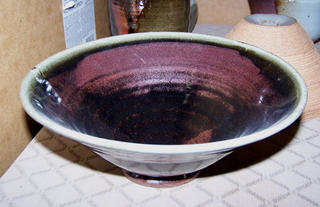 This first is a temmoku glazed bowl about 10 inches across. It was a nice piece before I glazed it; now it’s the most expensive thing on my shelves. Shiny things sell for more. I used this glaze on my tea mug and have received several compliments today at work.
This first is a temmoku glazed bowl about 10 inches across. It was a nice piece before I glazed it; now it’s the most expensive thing on my shelves. Shiny things sell for more. I used this glaze on my tea mug and have received several compliments today at work. Next we have a selection of items that are already for sale. Two vases in back, two cockroach traps in the middle. The bowl in the back is very attractive but the glaze on the left did not seal so it isn’t usable for food. The cockroach trap on the left is sized for Florida cockroaches, though the clay body on the smaller one is much nicer. These cockroach traps were made in the Mid-Atlantic area from the 1840s on to about the 1880s or so, when they were replaced by cheaper metal devices and chemicals. The way they worked was, you cork the hole in the bottom there, then fill the trap part way with a mixture of molasses and water. The roaches are attracted by the bait, climb up the rough unglazed exterior, and slip down the glazed downward slope into the trap. The inside is glazed smooth and the cockroach is unable to escape. Every week or so you pull the cork out and empty the trap.
Next we have a selection of items that are already for sale. Two vases in back, two cockroach traps in the middle. The bowl in the back is very attractive but the glaze on the left did not seal so it isn’t usable for food. The cockroach trap on the left is sized for Florida cockroaches, though the clay body on the smaller one is much nicer. These cockroach traps were made in the Mid-Atlantic area from the 1840s on to about the 1880s or so, when they were replaced by cheaper metal devices and chemicals. The way they worked was, you cork the hole in the bottom there, then fill the trap part way with a mixture of molasses and water. The roaches are attracted by the bait, climb up the rough unglazed exterior, and slip down the glazed downward slope into the trap. The inside is glazed smooth and the cockroach is unable to escape. Every week or so you pull the cork out and empty the trap. Here we have three cups. They all turned out pretty nice. The one in the foreground is priced at $18, which I thought seemed really steep but the owner of the studio said it was exactly right. In the middle is a cup that was extremely plain, so plain as to be quite boring and I figured what better to do with it than apply a very boring glaze. I really rather like the outcome; the glaze in question has become one of my favorites. In the back is a smaller cup with a very unique foot that was, sadly, more or less hidden by the amber celadon glaze.
Here we have three cups. They all turned out pretty nice. The one in the foreground is priced at $18, which I thought seemed really steep but the owner of the studio said it was exactly right. In the middle is a cup that was extremely plain, so plain as to be quite boring and I figured what better to do with it than apply a very boring glaze. I really rather like the outcome; the glaze in question has become one of my favorites. In the back is a smaller cup with a very unique foot that was, sadly, more or less hidden by the amber celadon glaze.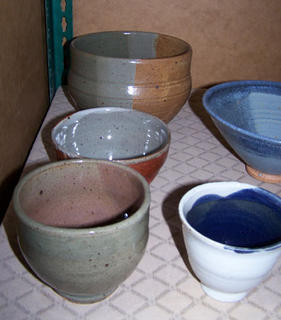 Now on the lower shelf we have some bowls. The one in back is big and heavy and not that nice. The one in front is glazed with Apple Blossom, my own glaze, and has a really terrific foot that the other potters are jealous of. It’s also more expensive than I think it should be, but what the hell. If it sells, it sells. The one in the middle, on the other hand, has a horrible carbon trap shino glaze on the outside and looks like a tomato that sat out in the sun too long. I'll be happy when it finally sells.
Now on the lower shelf we have some bowls. The one in back is big and heavy and not that nice. The one in front is glazed with Apple Blossom, my own glaze, and has a really terrific foot that the other potters are jealous of. It’s also more expensive than I think it should be, but what the hell. If it sells, it sells. The one in the middle, on the other hand, has a horrible carbon trap shino glaze on the outside and looks like a tomato that sat out in the sun too long. I'll be happy when it finally sells. The blue bowl here is one I made for myself, but I’m not as big on the glaze so it’s for sale. It has a terrific foot, cut like a diamond. The two little cups in front are glazed with a nickel blue celadon I invented. I like this glaze, but the nickel in the glaze has the unfortunate effect of floating to the surface of the glaze, so it always looks somewhat dusty.
The blue bowl here is one I made for myself, but I’m not as big on the glaze so it’s for sale. It has a terrific foot, cut like a diamond. The two little cups in front are glazed with a nickel blue celadon I invented. I like this glaze, but the nickel in the glaze has the unfortunate effect of floating to the surface of the glaze, so it always looks somewhat dusty. A chicken. This is unglazed; it’s going to go into a Japanese Anagama kiln, which should give it a nice multi-colored effect. I find chickens inherently funny. This one came from a bowl I had thrown whose sides folded in because I made them too thin. Just in looking at the fallen bowl, I realized it was clearly a chicken. There will be more chickens. There must be.
A chicken. This is unglazed; it’s going to go into a Japanese Anagama kiln, which should give it a nice multi-colored effect. I find chickens inherently funny. This one came from a bowl I had thrown whose sides folded in because I made them too thin. Just in looking at the fallen bowl, I realized it was clearly a chicken. There will be more chickens. There must be. A bowl, unglazed. This one has a foot similar to the blue bowl you saw earlier, and I intend to glaze it with the temmoku glaze I used on the first bowl. And then I’m going to take it home.
A bowl, unglazed. This one has a foot similar to the blue bowl you saw earlier, and I intend to glaze it with the temmoku glaze I used on the first bowl. And then I’m going to take it home. An unglazed 11-inch platter. I’ve never made a plate before, and for a first attempt, I’m quite happy with how this turned out. It has no foot and doesn’t sit entirely flat, but it’s nice all the same. Now I just have to try for one about twice that size.
An unglazed 11-inch platter. I’ve never made a plate before, and for a first attempt, I’m quite happy with how this turned out. It has no foot and doesn’t sit entirely flat, but it’s nice all the same. Now I just have to try for one about twice that size.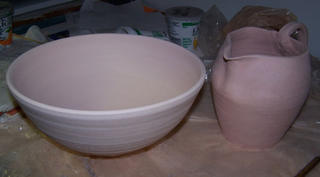 A bowl and a hideous ugly pitcher, both unglazed. I might raku fire the pitcher, or wood fire or something. Anything to make it even half attractive. To be honest I'm not sure why I kept the thing, but it's bisqued now and needs to be finished. Eventually. The bowl, on the other hand, is quite nice.
A bowl and a hideous ugly pitcher, both unglazed. I might raku fire the pitcher, or wood fire or something. Anything to make it even half attractive. To be honest I'm not sure why I kept the thing, but it's bisqued now and needs to be finished. Eventually. The bowl, on the other hand, is quite nice. Two more bowls. The one in back is much larger than the one in front, appearances to the contrary. Also unglazed. The one in back could have become a chicken if I'd been able to make the other side of it curl in like that. As it is it's more of a display or conversation piece than a useful piece of pottery, and as such is not the sort of thing I generally like to produce. The one in front has a nice shape but is somewhat heavy. I think I may raku fire it, as despite its size it at least has a very nice tea bowl sort of shape and should lend itself well to a raku firing. The one in back will probably get a celadon blue or something exotic to add interest and make it more saleable.
Two more bowls. The one in back is much larger than the one in front, appearances to the contrary. Also unglazed. The one in back could have become a chicken if I'd been able to make the other side of it curl in like that. As it is it's more of a display or conversation piece than a useful piece of pottery, and as such is not the sort of thing I generally like to produce. The one in front has a nice shape but is somewhat heavy. I think I may raku fire it, as despite its size it at least has a very nice tea bowl sort of shape and should lend itself well to a raku firing. The one in back will probably get a celadon blue or something exotic to add interest and make it more saleable.  A milk crock, a toy jar, and an urn; these are raw clay, haven’t even been bisqued yet. The crock is about 14 inches tall including the lid. The urn has a lid with a tiny little jug on it, just about an inch tall. I think it’s the smallest jug ever made and was very time consuming; the urn will as a result be very expensive. You can see my groovy stamp there on the bottom of the larger items--or at any rate you could if these pictures were larger. Rest assured it is quite groovy.
A milk crock, a toy jar, and an urn; these are raw clay, haven’t even been bisqued yet. The crock is about 14 inches tall including the lid. The urn has a lid with a tiny little jug on it, just about an inch tall. I think it’s the smallest jug ever made and was very time consuming; the urn will as a result be very expensive. You can see my groovy stamp there on the bottom of the larger items--or at any rate you could if these pictures were larger. Rest assured it is quite groovy. A simple unglazed jar of some sort, with no handles. About 10 inches. It's a very nice shape, but would have benefitted from two basic lugs, or perhaps a lid. As it is I think it will probably be relegated to the category "vase," a wide and disparate category containing any number of things you'd never use as vases. Vases are the tall versions of ashtrays. I don't know what you'd do with them. I'd say that if it doesn't sell I'd bring it home and use it to store old wine corks in, but it's very pretty and I suspect will sell right away. As is so frequently the case, the pieces I like the least are considered by my fellow studio artists to be the best or, at any rate, the ones most likely to sell. I think I put this one in to salt fire, but given the purple vase you'll see down below I wonder whether perhaps this one would be better with a similar glaze.
A simple unglazed jar of some sort, with no handles. About 10 inches. It's a very nice shape, but would have benefitted from two basic lugs, or perhaps a lid. As it is I think it will probably be relegated to the category "vase," a wide and disparate category containing any number of things you'd never use as vases. Vases are the tall versions of ashtrays. I don't know what you'd do with them. I'd say that if it doesn't sell I'd bring it home and use it to store old wine corks in, but it's very pretty and I suspect will sell right away. As is so frequently the case, the pieces I like the least are considered by my fellow studio artists to be the best or, at any rate, the ones most likely to sell. I think I put this one in to salt fire, but given the purple vase you'll see down below I wonder whether perhaps this one would be better with a similar glaze.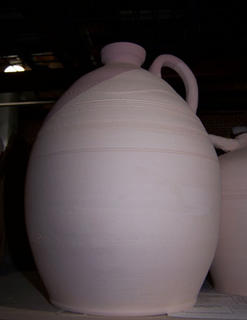 An extremely large jug after the Virginia style. I usually stay in the North and South Carolina regions for most of my inspiration (see the book Turners and Burners on my book list), but this jug more or less turned itself and I had very little say in the final outcome. It's about 1.5 gallons. I’m exceedingly proud of this piece and can’t wait for it to fire; I think it might be my very favorite of all the ones shown here.
An extremely large jug after the Virginia style. I usually stay in the North and South Carolina regions for most of my inspiration (see the book Turners and Burners on my book list), but this jug more or less turned itself and I had very little say in the final outcome. It's about 1.5 gallons. I’m exceedingly proud of this piece and can’t wait for it to fire; I think it might be my very favorite of all the ones shown here. The jug here is as I said Virginian. The jug pictured below is a North Carolina jug; note the differences between overall shape and especially the placement of the handles. These regional variations are very important to figuring out where an old piece of pottery comes from, should you ever wish to do such a thing. Of course I'd suggest you just buy new pottery from me...
 A jar and a jug, glazed and awaiting firing. The jar is about a gallon, the jug should be ¾. This is a North Carolina jug shape. This jug, and most all of the rest of my jugs, are shapes from about 1850 to 1880. After 1880 sides became straighter and the tops flatter, until by the 1920s you see the standard brown-on-top-white-on-bottom straight sided jug with a stacking flare. I see these types of things on sale on eBay from time to time as “Over 100 years old!” despite the fact that the form didn’t arise until mass storage and shipping requirements came about after the turn of the century.
A jar and a jug, glazed and awaiting firing. The jar is about a gallon, the jug should be ¾. This is a North Carolina jug shape. This jug, and most all of the rest of my jugs, are shapes from about 1850 to 1880. After 1880 sides became straighter and the tops flatter, until by the 1920s you see the standard brown-on-top-white-on-bottom straight sided jug with a stacking flare. I see these types of things on sale on eBay from time to time as “Over 100 years old!” despite the fact that the form didn’t arise until mass storage and shipping requirements came about after the turn of the century. More jugs, some rather small, glazed and awaiting firing. The fat little belly jug on the left there is a New England form (sorry about the handle not facing the camera and all). Jugs were not as common for storage in the northeast as they were south of the Mason Dixon line, though this actually has more to do with the ability of the jug form to keep things cool on hot days than with the Southern taste for whisky. Jugs were good for keeping far more than just whisky, not to disparage that fine libation.
More jugs, some rather small, glazed and awaiting firing. The fat little belly jug on the left there is a New England form (sorry about the handle not facing the camera and all). Jugs were not as common for storage in the northeast as they were south of the Mason Dixon line, though this actually has more to do with the ability of the jug form to keep things cool on hot days than with the Southern taste for whisky. Jugs were good for keeping far more than just whisky, not to disparage that fine libation.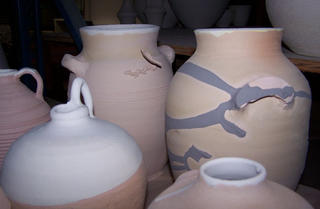 Two jars awaiting firing. All these things will be salt fired so as to look appropriately authentic. The drip glaze on the near jar is the nickel blue, which should look great under salt. The little curlicue on the back jar is a piece of clay I trimmed off the bottom of the jar. It looked cool, so I stuck it on; it may not survive the firing. These jars are not more than a gallon, probably slightly less. Jars from a half up to five gallons were standard production pieces; some potters turned 10 or 15 gallon jugs, though these were too heavy when full to be useful and were mostly used as advertising items.
Two jars awaiting firing. All these things will be salt fired so as to look appropriately authentic. The drip glaze on the near jar is the nickel blue, which should look great under salt. The little curlicue on the back jar is a piece of clay I trimmed off the bottom of the jar. It looked cool, so I stuck it on; it may not survive the firing. These jars are not more than a gallon, probably slightly less. Jars from a half up to five gallons were standard production pieces; some potters turned 10 or 15 gallon jugs, though these were too heavy when full to be useful and were mostly used as advertising items. The first large jug I ever made; 1 gallon. More nickel blue glaze. This jug is extremely heavy because I initially intended to trim some amount of clay off the bottom. However, I also didn't really intend to turn a jug this size; I figured I'd make two or three things out of the lump of clay I started with, so I left plenty at the bottom. I figure, though (I'm so naughty), that most people won't know the difference, especially if that nickel blue looks good.
The first large jug I ever made; 1 gallon. More nickel blue glaze. This jug is extremely heavy because I initially intended to trim some amount of clay off the bottom. However, I also didn't really intend to turn a jug this size; I figured I'd make two or three things out of the lump of clay I started with, so I left plenty at the bottom. I figure, though (I'm so naughty), that most people won't know the difference, especially if that nickel blue looks good. Some smaller items awaiting firing. The pitcher there is about the second successful piece I made after getting back in the studio this spring following a six-year absence. It's not a terrific item, but lots of people seem to like it and I've grown rather more fond of it. The little jug there in the extreme foreground to the left has some white X's carved into it with white glaze painted in. People want jugs to have X's on them, though in reality a jug was far more likely to have a number on it indicating its gallon capacity. These jugs are all one quart or less, though, so X's will have to suffice.
Some smaller items awaiting firing. The pitcher there is about the second successful piece I made after getting back in the studio this spring following a six-year absence. It's not a terrific item, but lots of people seem to like it and I've grown rather more fond of it. The little jug there in the extreme foreground to the left has some white X's carved into it with white glaze painted in. People want jugs to have X's on them, though in reality a jug was far more likely to have a number on it indicating its gallon capacity. These jugs are all one quart or less, though, so X's will have to suffice. A pickle jar. I absolutely adore this form and plan to make lots more. I’ve been making pickles at home lately, and I look forward to using a jar like this for the intended purpose. I find balsamic vinegar (which recipe books say you must never, ever use) makes really awesome pickles without any refrigeration at all. Simply put the cucumbers, cauliflower, or what-have-you (watermelon rind, maybe?) into the jar with straight balsamic vinegar, a bit of olive oil, and pickling spice. Leave it on the counter for two, maybe three days, then pour out the mixture through a sieve. Put the pickles in the jar, and fill with water and about a tablespoon or so of vinegar; float the pickling spice from the sieve in the mixture, and the pickles will keep in the fridge for months. Mmm. They're sweet and salty at the same time; very different from any pickle you're used to.
A pickle jar. I absolutely adore this form and plan to make lots more. I’ve been making pickles at home lately, and I look forward to using a jar like this for the intended purpose. I find balsamic vinegar (which recipe books say you must never, ever use) makes really awesome pickles without any refrigeration at all. Simply put the cucumbers, cauliflower, or what-have-you (watermelon rind, maybe?) into the jar with straight balsamic vinegar, a bit of olive oil, and pickling spice. Leave it on the counter for two, maybe three days, then pour out the mixture through a sieve. Put the pickles in the jar, and fill with water and about a tablespoon or so of vinegar; float the pickling spice from the sieve in the mixture, and the pickles will keep in the fridge for months. Mmm. They're sweet and salty at the same time; very different from any pickle you're used to.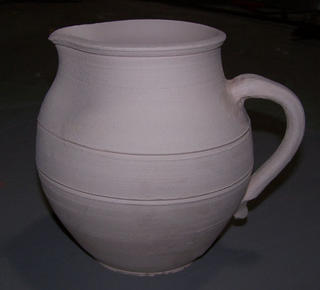 A nice pitcher that will salt fire. I really like this one but I’m afraid leaving it unglazed during the salt firing will make it a uniform brown. I couldn’t think what else to do with it, though; I'd considered dipping part of it in white or blue glaze, but it didn't seem right. This pitcher should be good for about a half gallon; the handle is nice and sturdy, and though things change during firing as of right now the spout pours very nicely. I may wood fire this piece, rather than salt fire it, since wood might tend to put more color on the surface.
A nice pitcher that will salt fire. I really like this one but I’m afraid leaving it unglazed during the salt firing will make it a uniform brown. I couldn’t think what else to do with it, though; I'd considered dipping part of it in white or blue glaze, but it didn't seem right. This pitcher should be good for about a half gallon; the handle is nice and sturdy, and though things change during firing as of right now the spout pours very nicely. I may wood fire this piece, rather than salt fire it, since wood might tend to put more color on the surface.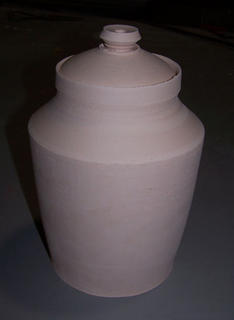 A milk crock, freakishly smooth. Curious to see how well the salt sticks to it. I threw this one using two ribs instead of a sponge, and the result is... well, it looks almost machined. Maybe poured into a mould or something. Anyway, the lid there is one of the first I'd made in many years and I think turned out very nice all things considered.
A milk crock, freakishly smooth. Curious to see how well the salt sticks to it. I threw this one using two ribs instead of a sponge, and the result is... well, it looks almost machined. Maybe poured into a mould or something. Anyway, the lid there is one of the first I'd made in many years and I think turned out very nice all things considered.  Two jugs awaiting glaze. These are two different clay bodies, but I’m not at all sure what clay bodies they are. These are about half to three-quarter gallon jugs. They're both Carolina-inspired, but note the difference in handle placement and body shape between the jug on the left (Piedmont) and the one of the right (South Carolina). As a rule I prefer the Piedmont style handle but the South Carolina shape.
Two jugs awaiting glaze. These are two different clay bodies, but I’m not at all sure what clay bodies they are. These are about half to three-quarter gallon jugs. They're both Carolina-inspired, but note the difference in handle placement and body shape between the jug on the left (Piedmont) and the one of the right (South Carolina). As a rule I prefer the Piedmont style handle but the South Carolina shape. A nice slender jug. It’s got a strong copper glaze on the top of it now, should look real nice when it comes out of the kiln. I hope. Note to the fair AMS, if you don’t like another piece better, this is the one I had in mind for you.
A nice slender jug. It’s got a strong copper glaze on the top of it now, should look real nice when it comes out of the kiln. I hope. Note to the fair AMS, if you don’t like another piece better, this is the one I had in mind for you.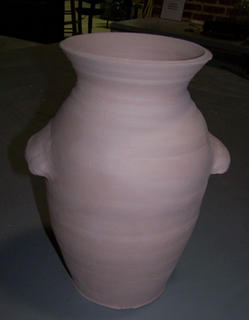 A two gallon jar with very unfortunate handles. I've since learned to make much nicer lug handles, which you can see on the crock above (the one pictured with the toy jar and the urn).
A two gallon jar with very unfortunate handles. I've since learned to make much nicer lug handles, which you can see on the crock above (the one pictured with the toy jar and the urn). The grotesque! It’s a two gallon jar. His facial features and handles are a different clay body than the jar itself, which, at the time, I did not realize I had done. We’ll see how it looks coming out of the kiln. While numerous other potters have expressed dismay at how, well, ugly this piece is, most of them concede that this will probably sell first and at a ridiculous price. Grotesques (or “face jugs”) are very popular among collectors of old pottery but made up a very small percentage of the potter’s usual production. Mostly they would be made on special order, but sometimes, as in the case here, an off-center or otherwise imperfect jug or jar could be “saved” (that hardly seems the right word) by making it into a grotesque.
The grotesque! It’s a two gallon jar. His facial features and handles are a different clay body than the jar itself, which, at the time, I did not realize I had done. We’ll see how it looks coming out of the kiln. While numerous other potters have expressed dismay at how, well, ugly this piece is, most of them concede that this will probably sell first and at a ridiculous price. Grotesques (or “face jugs”) are very popular among collectors of old pottery but made up a very small percentage of the potter’s usual production. Mostly they would be made on special order, but sometimes, as in the case here, an off-center or otherwise imperfect jug or jar could be “saved” (that hardly seems the right word) by making it into a grotesque. A selection of pieces for size comparison. The grotesque is 15 inches tall.
A selection of pieces for size comparison. The grotesque is 15 inches tall.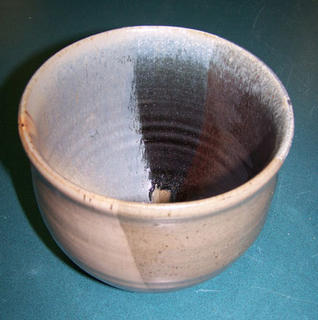 A large vase I just pulled out of the kiln with very intriguing glaze. I like these triple-dip things, where I can see what different glazes do in reaction with others.
A large vase I just pulled out of the kiln with very intriguing glaze. I like these triple-dip things, where I can see what different glazes do in reaction with others.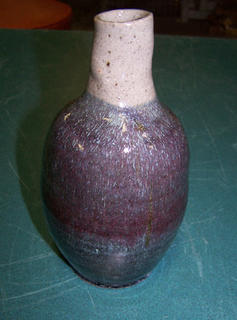 A smaller, partially-destroyed vase I just got out of the kiln. I’ve never made a purple glaze before, though I have tried several times. This was a very nice little piece (about eight inches tall) when I threw it, but I trimmed it upside down (which seemed like a good idea at the time) in an effort to give it a foot, and ended up warping it. Some quick handbuilding saved the piece, but it’s no longer as pretty or regular as it was. The purple glaze, which was not my intention and which I have no idea how I produced, makes this a much nicer piece than I ever would have hoped.
A smaller, partially-destroyed vase I just got out of the kiln. I’ve never made a purple glaze before, though I have tried several times. This was a very nice little piece (about eight inches tall) when I threw it, but I trimmed it upside down (which seemed like a good idea at the time) in an effort to give it a foot, and ended up warping it. Some quick handbuilding saved the piece, but it’s no longer as pretty or regular as it was. The purple glaze, which was not my intention and which I have no idea how I produced, makes this a much nicer piece than I ever would have hoped.So there you have it. I’ll have more pictures as these items come out of the kilns and as I make new stuff.
3 comments:
Nice man. I'm glad to see you are enjoying it. The jugs are friggin awsome as usual. I must say that I really like the last piece you have pictured. It reminds me of a purple fruit, olive?, or root with an irregular stem or top trimmed off. I kind of want to see something orange in it, maybe asters or lilies.
Thanks for the great pictures! You will definitely have to figure out how to reproduce that purple glaze. I like it! If you're taking requests for things to throw, I'm sure I could come up with something... I definitely like the jug on the left in jugs.jpeg, and I wonder how it would look in Apple Blossom.
Enjoyed seeing the fruits of all your efforts--and reading your descriptions. Hope the show/sale is successful. I have a few favorites--let us know what is left after this weekend. (And, of course, I like the apple blossom glaze!) AWS
Post a Comment